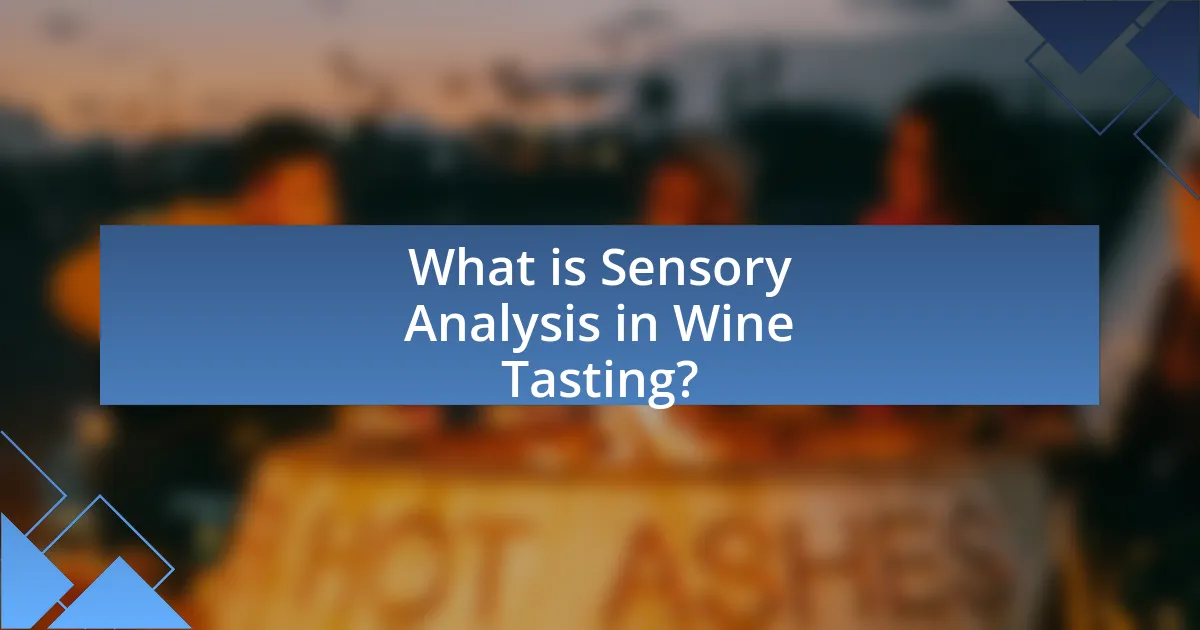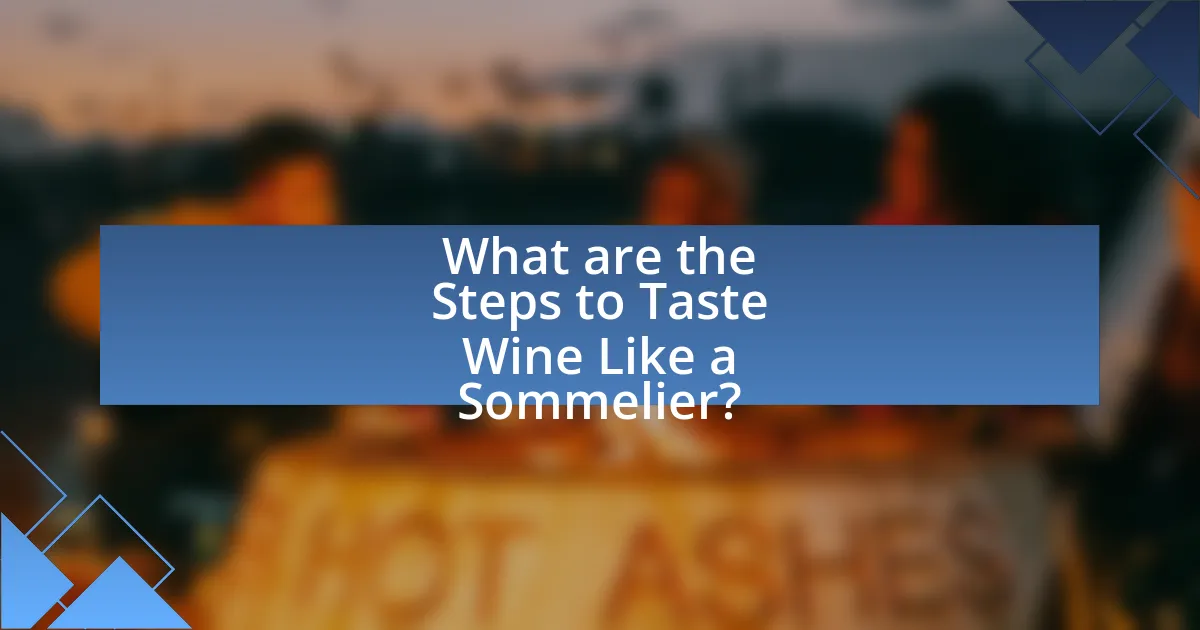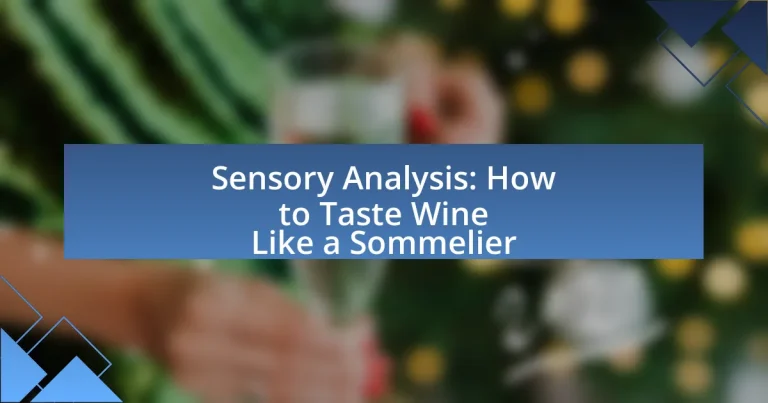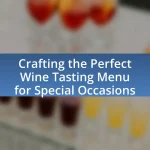Sensory analysis in wine tasting is a systematic method for evaluating the sensory attributes of wine, including appearance, aroma, taste, and mouthfeel. This article explores how sensory analysis enhances the wine tasting experience by engaging the senses and allowing for a comprehensive understanding of wine quality and style. Key senses involved in this process are taste, smell, sight, touch, and hearing, which collectively contribute to the overall perception of wine. The article also highlights the importance of sensory analysis for sommeliers, detailing the skills they develop and how it influences wine selection and pairing. Additionally, practical steps for tasting wine like a sommelier, preparation tips for tasting sessions, and resources for aspiring sommeliers are discussed, providing a thorough guide to improving wine tasting skills.

What is Sensory Analysis in Wine Tasting?
Sensory analysis in wine tasting is a systematic approach to evaluating the sensory attributes of wine, including its appearance, aroma, taste, and mouthfeel. This method employs trained panels or individual tasters to assess these characteristics, allowing for a comprehensive understanding of the wine’s quality and style. Research indicates that sensory analysis can enhance the accuracy of wine evaluations, as demonstrated in studies where trained tasters consistently identified specific flavor profiles and quality indicators in various wine samples.
How does sensory analysis enhance the wine tasting experience?
Sensory analysis enhances the wine tasting experience by systematically evaluating the wine’s aroma, flavor, and texture, allowing tasters to identify and appreciate its complexities. This method involves engaging the senses—sight, smell, taste, and even touch—to create a comprehensive understanding of the wine’s characteristics. For instance, studies show that trained tasters can detect subtle differences in wine profiles, such as variations in acidity and tannin levels, which contribute to the overall tasting experience. By employing sensory analysis, individuals can articulate their perceptions more accurately, leading to a deeper appreciation of the wine’s quality and origin.
What are the key senses involved in sensory analysis?
The key senses involved in sensory analysis are taste, smell, sight, touch, and hearing. Taste and smell are particularly crucial as they directly influence flavor perception; taste identifies basic flavors such as sweet, sour, salty, bitter, and umami, while smell contributes to the complexity of flavors through aroma detection. Sight allows for the assessment of color and clarity, which can indicate quality and age in wine. Touch provides information on texture and mouthfeel, and hearing can play a role in the overall experience, such as the sound of a cork popping. These senses collectively enhance the evaluation of products, particularly in wine tasting, where a comprehensive sensory profile is essential for quality assessment.
How do these senses contribute to the overall perception of wine?
The senses of sight, smell, taste, and touch significantly contribute to the overall perception of wine. Sight allows individuals to assess the wine’s color and clarity, which can indicate its age and quality; for example, a deep red color often suggests a full-bodied wine. Smell, or olfaction, plays a crucial role as it enables the identification of various aromas, such as fruity, floral, or earthy notes, which can enhance the tasting experience; studies show that up to 80% of flavor perception comes from smell. Taste provides the fundamental flavors—sweetness, acidity, bitterness, and umami—that define the wine’s profile, while touch, through the texture and mouthfeel, influences the perception of body and tannins. Together, these senses create a comprehensive understanding of the wine, allowing for a more nuanced appreciation of its characteristics.
Why is sensory analysis important for sommeliers?
Sensory analysis is crucial for sommeliers because it enables them to evaluate and describe the complex flavors, aromas, and textures of wines accurately. This skill is essential for making informed recommendations to customers, enhancing their wine experience, and ensuring proper food pairings. Research indicates that trained sommeliers can identify over 1,000 different aromas in wine, which underscores the importance of sensory analysis in distinguishing between various wine profiles and qualities.
What skills do sommeliers develop through sensory analysis?
Sommeliers develop critical tasting skills through sensory analysis, which include the ability to identify and differentiate various aromas, flavors, and textures in wine. This skill set enables them to assess wine quality, understand varietal characteristics, and recognize faults. For instance, through systematic tasting practices, sommeliers learn to detect specific notes such as fruit, floral, or earthy elements, enhancing their overall wine evaluation capabilities. Additionally, sensory analysis fosters the development of a refined palate, allowing sommeliers to articulate their tasting experiences effectively, which is essential for guiding customers in wine selection.
How does sensory analysis influence wine selection and pairing?
Sensory analysis significantly influences wine selection and pairing by evaluating the wine’s aroma, taste, and mouthfeel, which helps determine its compatibility with food. This method allows sommeliers and consumers to identify specific flavor profiles and textures in wine, such as acidity, sweetness, and tannin levels, which are crucial for pairing with various dishes. For instance, a study published in the Journal of Sensory Studies found that wines with higher acidity pair well with fatty foods, as the acidity cuts through the richness, enhancing the overall dining experience. Thus, sensory analysis serves as a foundational tool in making informed wine choices that complement culinary offerings.

What are the Steps to Taste Wine Like a Sommelier?
To taste wine like a sommelier, follow these steps: first, observe the wine’s appearance by examining its color and clarity against a white background. Next, swirl the wine gently in the glass to release its aromas, then bring the glass to your nose and inhale deeply to identify the scents. After that, take a small sip and let the wine coat your palate, paying attention to its flavors, acidity, tannins, and body. Finally, evaluate the finish, noting how long the flavors linger after swallowing. These steps are essential for a comprehensive sensory analysis, as sommeliers rely on visual, olfactory, and gustatory cues to assess wine quality and characteristics.
How should one prepare for a wine tasting session?
To prepare for a wine tasting session, one should ensure to have the right environment, appropriate glassware, and a neutral palate. A quiet, well-lit space free from strong odors enhances the sensory experience. Using clean, tulip-shaped wine glasses allows for better aroma concentration and appreciation. Additionally, participants should avoid strong foods, perfumes, or smoking prior to the tasting to maintain a neutral palate, which is crucial for accurately assessing the wine’s flavors and aromas. These preparations align with best practices in sensory analysis, ensuring a more enjoyable and informative tasting experience.
What tools and materials are necessary for effective tasting?
Effective tasting requires specific tools and materials, including a clean glass, a spittoon, a notebook, and a pen. The clean glass allows for proper observation of the wine’s color and clarity, while the spittoon enables tasters to discard wine without swallowing, preserving palate sensitivity. A notebook and pen are essential for recording observations, aromas, and flavors, facilitating a structured analysis of the tasting experience. These tools collectively enhance the accuracy and enjoyment of the tasting process, aligning with best practices in sensory analysis.
How does the environment affect the tasting experience?
The environment significantly influences the tasting experience by affecting sensory perceptions such as aroma, flavor, and texture. Factors like temperature, humidity, lighting, and even background noise can alter how a wine is perceived. For instance, warmer temperatures can enhance the perception of sweetness in wine, while cooler temperatures may emphasize acidity. Additionally, studies have shown that ambient conditions, such as the presence of certain scents or sounds, can impact the overall enjoyment and evaluation of wine, as demonstrated in research published in the journal “Food Quality and Preference,” which highlights how environmental cues can shape taste perception.
What are the specific steps involved in tasting wine?
The specific steps involved in tasting wine are: visual examination, olfactory assessment, and gustatory evaluation. First, during visual examination, the taster observes the wine’s color, clarity, and viscosity by holding the glass against a white background. This step helps identify the wine’s age and potential quality. Next, in olfactory assessment, the taster swirls the wine to release its aromas and then inhales deeply to identify various scents, which can indicate the grape variety and region of origin. Finally, during gustatory evaluation, the taster takes a sip, allowing the wine to coat the palate, and assesses its flavors, acidity, tannins, and finish. This comprehensive approach enables a thorough understanding of the wine’s characteristics and quality.
How do you evaluate the appearance of wine?
To evaluate the appearance of wine, one should observe its color, clarity, and viscosity. The color can indicate the grape variety and age; for example, red wines may range from deep purple to brick red, while white wines can vary from pale yellow to golden hues. Clarity refers to the wine’s transparency; a clear wine suggests proper filtration and quality, while cloudiness may indicate faults. Viscosity, often assessed by swirling the wine in the glass, can be observed through the formation of “legs” or “tears” that run down the glass, indicating alcohol content and body. These visual characteristics provide essential insights into the wine’s quality and style.
What techniques are used to assess the aroma of wine?
Techniques used to assess the aroma of wine include sniffing, swirling, and using aroma kits. Sniffing allows tasters to detect volatile compounds released from the wine, while swirling enhances the release of these compounds by increasing surface area exposure to air. Aroma kits, which contain various scent samples, help tasters identify specific aromas present in the wine. These methods are supported by sensory analysis practices that emphasize the importance of olfactory perception in wine tasting.
How do you analyze the taste and finish of wine?
To analyze the taste and finish of wine, one should focus on the primary flavors, mouthfeel, and the duration of the aftertaste. The tasting process begins with identifying the initial flavors, which can include fruit, acidity, tannins, and sweetness. Next, the mouthfeel is assessed, considering factors such as body, texture, and balance. Finally, the finish is evaluated by noting how long the flavors linger after swallowing and the complexity of those lingering tastes. Research indicates that a well-structured wine will have a harmonious balance of these elements, contributing to a more enjoyable tasting experience.

What Techniques Can Improve Your Wine Tasting Skills?
To improve your wine tasting skills, practice systematic sensory analysis by focusing on sight, smell, taste, and texture. This method allows you to evaluate wines more thoroughly. For instance, observing the color and clarity can indicate the wine’s age and quality, while swirling the glass releases aromatic compounds, enhancing the olfactory experience. Tasting should involve assessing sweetness, acidity, tannins, and body, which are fundamental components of wine. Research shows that trained tasters can identify specific flavor profiles and nuances, leading to a deeper appreciation and understanding of different wines. Regular practice and exposure to various wine styles further refine these skills, making sensory analysis an effective technique for improving wine tasting abilities.
How can practice enhance your sensory analysis abilities?
Practice enhances sensory analysis abilities by refining the ability to detect and differentiate various sensory attributes in wine. Through repeated exposure to different wines, individuals can develop a more acute sense of smell and taste, allowing them to identify subtle nuances such as aroma profiles, flavor notes, and textural elements. Research indicates that sensory training can improve discrimination skills; for example, a study published in the Journal of Sensory Studies found that trained tasters could identify specific flavor compounds more accurately than untrained individuals. This consistent practice not only builds confidence but also enhances memory recall of sensory experiences, leading to more informed and nuanced evaluations in sensory analysis.
What exercises can help refine your palate?
To refine your palate, engage in systematic tasting exercises that focus on identifying and differentiating flavors. One effective method is the “Flavor Wheel” exercise, where you taste various wines and use a flavor wheel to pinpoint specific aromas and tastes, enhancing your ability to recognize subtle differences. Additionally, blind tasting sessions can improve your sensory discrimination; by tasting wines without knowing their identities, you train your palate to rely on sensory cues rather than preconceived notions. Research indicates that repeated exposure to diverse flavor profiles significantly enhances sensory perception, making these exercises valuable for developing a refined palate.
How can you learn to identify different wine aromas and flavors?
To learn to identify different wine aromas and flavors, engage in systematic tasting and sensory training. This involves practicing with a variety of wines while focusing on specific aroma and flavor profiles, such as fruity, floral, or earthy notes. Utilizing aroma kits that contain various scent samples can enhance your ability to recognize these characteristics in wine. Research indicates that repeated exposure to specific aromas improves recognition skills, as demonstrated in studies on olfactory training. Additionally, keeping a tasting journal to note observations can reinforce learning and help track progress in identifying wine aromas and flavors.
What resources are available for aspiring sommeliers?
Aspiring sommeliers can access a variety of resources to enhance their knowledge and skills in wine tasting and sensory analysis. Key resources include formal education programs such as the Court of Master Sommeliers, which offers structured courses and certifications, and the Wine & Spirit Education Trust (WSET), known for its globally recognized qualifications in wine and spirits. Additionally, books like “The Wine Bible” by Karen MacNeil and “Windows on the World Complete Wine Course” by Kevin Zraly provide comprehensive insights into wine tasting techniques and varietals. Online platforms like MasterClass and various YouTube channels also offer tutorials and expert advice on sensory analysis. These resources collectively support aspiring sommeliers in developing their expertise in wine tasting.
How can wine tasting courses benefit your skills?
Wine tasting courses enhance your skills by providing structured education on sensory analysis, enabling you to identify and articulate various wine characteristics. These courses teach participants to recognize aromas, flavors, and textures, which are essential for developing a refined palate. Research indicates that formal training in sensory evaluation significantly improves the ability to distinguish between different wine profiles, as evidenced by studies showing that trained tasters can identify specific varietals and regions with greater accuracy than untrained individuals. Additionally, engaging in guided tastings fosters critical thinking and decision-making skills related to wine selection and pairing, further enhancing overall expertise in the field.
What role do wine tasting events play in skill development?
Wine tasting events play a crucial role in skill development by enhancing sensory evaluation abilities and deepening knowledge of wine characteristics. Participants engage in systematic tasting practices that refine their palate, enabling them to identify various aromas, flavors, and textures in wines. Research indicates that repeated exposure to diverse wine profiles during these events significantly improves individuals’ ability to discern subtle differences, which is essential for aspiring sommeliers. Additionally, wine tasting events often include educational components, such as discussions on terroir, grape varieties, and winemaking techniques, further enriching participants’ understanding and expertise in the field.
What are some practical tips for tasting wine like a sommelier?
To taste wine like a sommelier, follow these practical tips: first, observe the wine’s appearance by examining its color and clarity against a white background. This helps assess its age and quality. Next, swirl the wine gently in the glass to release its aromas, then take a moment to inhale deeply, identifying various scents such as fruit, floral, or earthy notes. After that, take a small sip and let the wine coat your palate, paying attention to its flavors, acidity, tannins, and body. Finally, consider the finish, noting how long the flavors linger after swallowing. These steps align with sommelier training, which emphasizes a systematic approach to wine tasting for accurate evaluation.
How can you create a personal tasting notebook?
To create a personal tasting notebook, begin by selecting a dedicated notebook or digital app specifically for recording your tasting experiences. This notebook should include sections for essential details such as the wine’s name, vintage, region, varietal, and producer. Additionally, incorporate space for sensory observations, including appearance, aroma, taste, and finish, allowing for a structured analysis of each wine.
For effective documentation, consider using a consistent rating system, such as a numerical scale or descriptive terms, to evaluate each wine’s characteristics. This structured approach not only enhances your tasting skills but also provides a valuable reference for future selections. Research indicates that systematic note-taking improves memory retention and sensory evaluation skills, making it a beneficial practice for wine enthusiasts.
What common mistakes should you avoid during wine tasting?
Common mistakes to avoid during wine tasting include not properly assessing the wine’s appearance, neglecting to swirl the wine, and failing to take adequate time for smelling and tasting. Assessing the wine’s appearance is crucial as it provides initial insights into its clarity and color, which can indicate age and quality. Swirling the wine aerates it, releasing aromas that are essential for a full tasting experience. Additionally, rushing through the smelling and tasting phases can lead to missing important flavor notes and nuances, which are vital for a comprehensive evaluation. These practices are supported by wine tasting guidelines from experts, emphasizing the importance of a systematic approach to enhance sensory perception.


